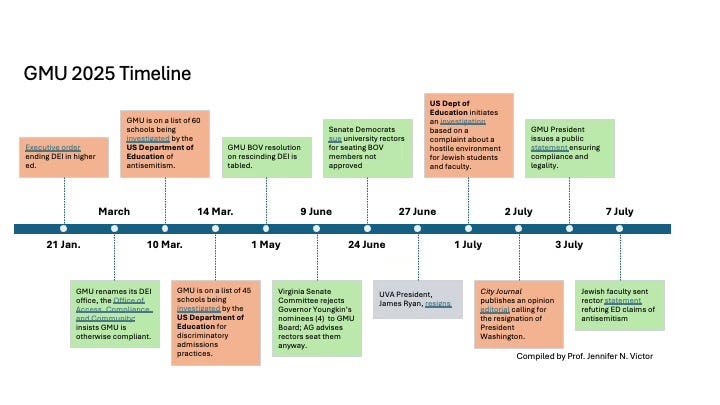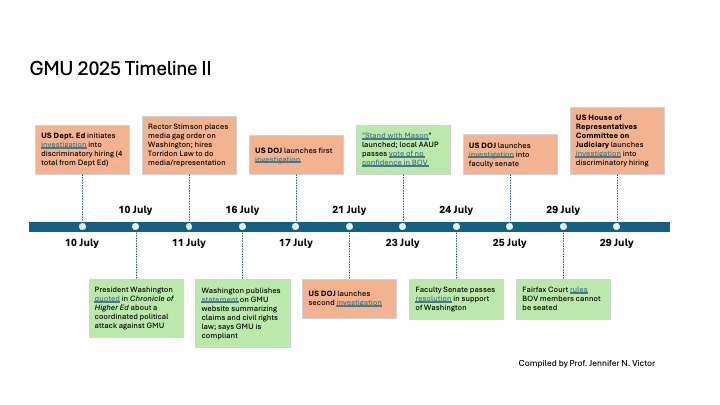Authoritarians are attacking universities. Here's how it's going at one public school.
I'm publicly documenting an event timeline to help bring order to the chaotic nature of events and help other schools plan the responses they are likely going to need.
As a political science professor at a university that is currently under eight federal investigations that are being openly disputed, I have a particular point of view on events. In this post, I provide a summary of events as part of an effort to contribute to public documentation. This serves a few purposes.
First, the ongoing federal investigations at universities are multiplying. It’s nearly impossible to follow. To date there have been eight different federal investigations launched at George Mason University (six since July 1) by three different entities—two in the executive branch (US Dept. of Education and US Dept. of Justice) and one from the legislative branch (House Judiciary Committee). As news reports try to keep up with these events, it’s natural for even attentive observers to get confused about what is happening (“Didn't I already see that headline?”). Who can possibly keep track?
The frenzied nature of these actions is part of the administration’s strategy—overwhelm and intimidate. Make it seem like complying with each demand will make them stop. But what universities are learning, that authoritarian scholars already know and have been saying, is that complying with illegitimate attacks does not make them stop—it makes them continue.
Second, universities face enormous collective action problems in responding to these charges. Universities are made up of people who naturally collaborate all the time—that’s just part of how scholarship works—what they don’t naturally do is provide legal, financial, and public backing of one another, across institutions. As institutions, universities are more in competition with one another (for students, for grants, for faculty, etc.) than not. Building a NATO-style Article V coalition that promises collective defense against attacks is logistically prohibitive. But the authoritarianism literature suggests that such a coalition is the best way to endure authority overreach.
By providing a timeline of events, other university presidents, faculty senates, student orgs, faculty coalitions, or governing boards can learn from the experience of others and hopefully improve their responses. I think it’s likely that Mason’s president, Dr. Gregory Washington, has learned by watching what’s happened at UVA, Harvard, Columbia, Brown and elsewhere, and made some different choices.
Laid out as a timeline you can appreciate the escalation of events. The timing and sequence of events also suggests a retaliatory nature to the escalations.
Mason is also different in a few other ways. GMU is a big public school—40,000 students. It accepts around 90 percent of the students who apply to attend. It’s research active, innovative, and dynamic (I really like working there!), but it’s not an “elite” university. It doesn’t have an endowment, and on a per student basis it receives far less support from the state compared to the public flagship, UVA. In short, Mason cannot withstand the same type of financial penalties that have been thrown at Ivy League schools.
But maybe that’s also a strategic advantage, of sorts. Without a big endowment to protect, there is less to lose and maybe that makes it easier to fight back. By all accounts it seems like Mason’s president is doing things a bit differently than his counterparts at other schools. Despite a media gag order from the governing board, Washington defends the university, the legality of its policies, and the historical context for promoting diversity in education access.
Innovation. Collaboration. These are higher education’s competitive advantage in all things, especially now.
So, with the confidence that transparency is the best disinfectant, here’s the timeline, with links. Low res visualizations follow.
Federal Interference Timeline - GMU 2025
January 21 – President Trump signs an executive order to end diversity, equity, and inclusion (DEI) at all universities that receive federal money. The administration claims DEI policies violate civil rights laws because they discriminates against white and Asian people.
March – GMU renames its DEI office the Office of Access, Compliance, and Community, but does not make policy or programmatic changes in response to the federal order after having determined the university was already in compliance.
March 10 - GMU is on a list of 60 schools being investigated by the US Department of Education for antisemitism. (#1)
March 14 – GMU is on a list of 45 schools being investigated by the US Department of Education for discriminatory admissions practices related to participation with a program called “The PhD Project.” (#2)
May 1 – GMU BOV considers a resolution, to comply with the EO, to prohibit race from being considered in hiring, admissions, and “all aspects of students, academic, and campus life.” The resolution was tabled, seemingly as a result of protests.
June 9 – Virginia Senate Committee on Privileges and Elections rejected Governor Youngkin’s nominees to university Governing Boards in an 8-4 vote. State Attorney General Jason Miyares advised university rectors to seat them anyway.
June 24 – All eight Democrats on the Senate committee and Senate President Pro Tempore L. Louis Lucas sued the university rectors arguing that gubernatorial appointees who are not confirmed by the Senate cannot be seated. The Attorney General argues that only a full vote of the General Assembly can reject an appointee.
June 27 – UVA President, James Ryan, announces resignation in order to resolve Department of Justice investigations.
July 1 – US Dept of Education initiates an investigation based on a complaint about a hostile environment for Jewish students and faculty. (#3)
July 2 – City Journal publishes an opinion editorial calling for the resignation of President Washington.
July 3 – GMU President issues a public statement ensuring compliance and legality.
July 7 – Jewish faculty at GMU send a statement to rector Stimson refuting the Department of Education’s antisemitism claims.
July 10 – US Dept of Education initiates a second investigation into discriminatory hiring practices at GMU. (#4)
July 10 – Chronicle of Higher Education article appears in which President Washington is says he suspects the campaign against GMU is a politically coordinated attack. Washington says the City Journal piece recommends elevating the investigations against GMU to the Department of Justice.
July 11 – Media gag: BOV rector, Charles Stimson, instructs President Washington not to talk to the press; BOV hires Torridon Law to represent the university in all investigation matters.
July 16 – President Washington releases a statement updating the university community on the status of events. In it, he clarifies how hiring, promotion, and admissions practices are fully within the law. He also provides a summary of the purpose and history of Title VI of the Civil Rights Act
July 17 – US Department of Justice launches an investigation into discriminatory hiring practices at GMU. (Letter) (#5)
July 21 – US Department of Justice launches second investigation into discriminatory hiring practices. (Letter) (#6)
July 23 – “Stand with Mason” campaign is launched. AAUP chapter passes vote of no confidence in the Board of Visitors.
July 24 – GMU Faculty Senate passes a resolution in support of the university mission, its current president, and an external evaluation of performance of President Washington.
July 25 – US Department of Justice, civil rights division, notified Board of Visitors Rector, Charles Stimson, that it’s investigating the faculty senate for its July 24 resolution. (#7)
July 29 – Fairfax County Circuit Court judge ruled that eight university governing board appointees (4 for GMU) will be suspended while the legal challenges play out.
July 29 – US House of Representatives Judiciary Committee launches investigation into discriminatory hiring practices at GMU. (#8)
Any mistakes above are mine alone.
Laid out as a timeline you can appreciate the escalation of events. The timing and sequence of events also suggests a retaliatory nature to the escalations.
Tomorrow, the governing board at GMU is scheduled to meet and evaluate the job performance of President Washington. It promises to be a well-attended event. Scheduling a Board meeting for August 1 may be an unforced error on the part of the Board—academics loathe August 1.
This piece was edited for typos and updated on August 1, 2025 at 6:53am EDT.




The authoritarian attacks on higher education are following the plan outlined in Project Esther, a national strategy produced by the Heritage Foundation.
https://www.heritage.org/sites/default/files/2024-10/Project%20Esther.pdf
This critique of Project Esther by the Jewish Voice for Peace Academic Advisory Council exposes the bad faith effort to exploit accusations of antisemitism, in order to "limit pro-Palestine activism, but to use attacks on Palestine solidarity to also strike out at fields such as Critical Theory, Ethnic Studies, and Gender and Women’s Studies, university initiatives including but not limited to DEI, and movements like migrant justice and Black Lives Matter..." This matches the escalating authoritarian attacks on higher education we're witnessing today.
https://contendingmodernities.nd.edu/global-currents/jvp-rejecting-project-esther/